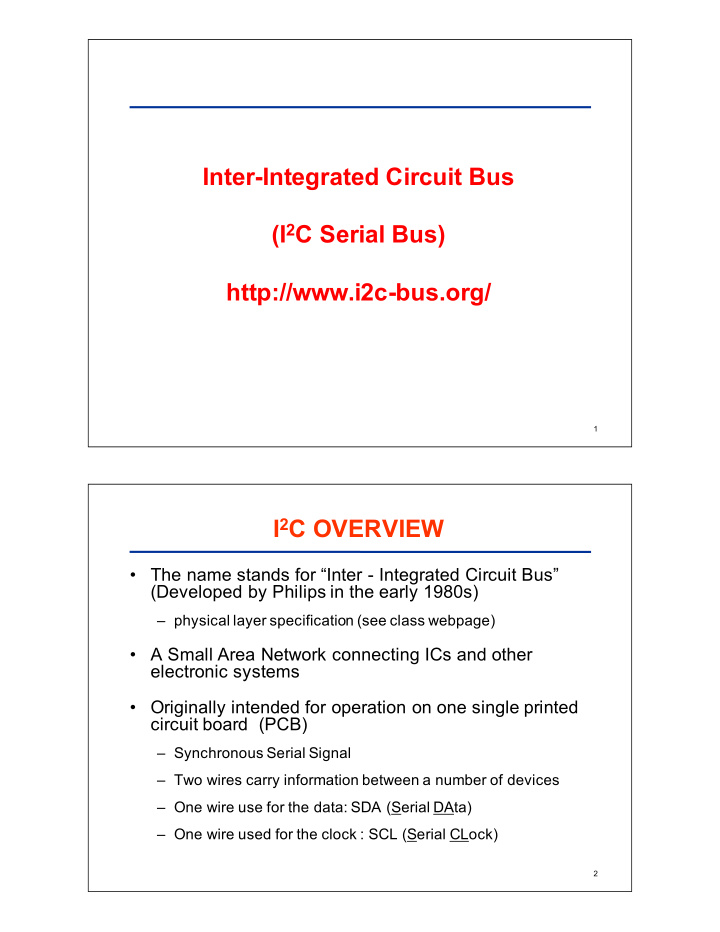



Inter&Integrated*Circuit*Bus (I 2 C*Serial*Bus) http://www.i2c&bus.org/ 1 I 2 C*OVERVIEW • The'name'stands'for'“Inter'3 Integrated'Circuit'Bus”' (Developed'by'Philips'in'the'early'1980s) – physical'layer'specification'(see'class'webpage) • A'Small'Area'Network'connecting'ICs'and'other' electronic'systems • Originally'intended'for'operation'on'one'single'printed' circuit'board''(PCB)' – Synchronous'Serial'Signal' – Two'wires'carry'information'between'a'number'of'devices' – One'wire'use'for'the'data:'SDA'(Serial'DAta) – One'wire'used'for'the'clock':'SCL'(Serial'CLock) 2
I 2 C*USAGE • Examples'of'I 2 C3compatible'devices'found'in' embedded'systems'include: - Microcontrollers - EEPROMs - Real3Timers - interface'chips - LCD'drivers - Data'A/D'converters'(A/D'and'D/A) • Can'be'Found'in'the'following: – interconnecting'subcircuits'within'a'core – interconnecting'cores'in'SoC – interconnecting'ICs'on'a'board – interconnecting'boards'on'a'backplane – in'some'cases'interconnecting'rack'mounted'chassis 3 I 2 C*Bus*Embedded*System*Example Other'Output Actuators Sensors Could'be'DSP'or'other'Co3Processor 4
I 2 C Characteristics • 3'levels'of'data'transfer'rate – 100kbps'in'standard'mode – 400kbps'in'Fast'mode – 3.4'Mbps'in'high3speed'mode • Standard'is'open'(not'proprietary) • Requires'only'2'Signal'Conductors'(higher' reliability'uses'dedicated'ground) • Many'Supporting'Chips'and'Cores'Available • Other'Popular'Serial'Busses: – EIA3232C'(commonly'referred'to'by'its'older'name'RS3 232) – Universal'Serial'Bus'(USB) – Firewire'(IEEE'Standard'1394) 5 I 2 C*Bus*Characteristics • Includes'electrical'and'timing'specifications,' and'an'associated'bus'protocol' • Two'wire'serial'data'&'control'bus'implemented'with' the'serial'data'(SDA)'and'clock'(SCL)'lines' – For'reliable'operation,'a'third'line'is'required: Common'ground' – Shielded'Twisted'Pair'Cabling • Unique'start'and'stop'condition' • Slave'selection'protocol'uses'a'73Bit'slave'address' – The'bus'specification'allows'an'extension'to'10'bits' • Bi3directional'data'transfer' • Acknowledgement'after'each'transferred'byte' • No'fixed'length'of'transfer'3 Ramifications' 6
I 2 C*Bus*Characteristics*(cont’d) • True'multi3master'capability' – Clock'synchronization' – Arbitration'procedure' • Transmission'speeds'up'to'100Khz' (classic'I2C)' • Max.'line'capacitance'of'400pF, approximately'4'meters'(12'feet)' • Allows'series'resistor'for'IC'protection' • Compatible'with'different'IC'technologies 7 Physical*I 2 C*Bus • Pull3up'Resistor'Needed'Since'SCL/SDA'are'Open3Drain' Drivers • can'pull'line'low'but'not'high'w/o'pull3up • 1.8k'to'47k'Ohm'typical'– depends'on'device'specs • Need'Third'Reference/GND'Conductor • Shielded'Twisted'Pair'for'cabling'works'well 8
Why*I2C*has*endured? • Reliable'performance'using'software3controlled'collision' detection'and'arbitration. – Collision'detection/arbitration'is'ALWAYS'a'concern – Collisions'can'occur'when'two'Masters'attempt'to'broadcast'within' the'same'period'of'time – Some'collision'arbitration'schemes'can'be'quite'complex'such'as' the'Ethernet'CSMA'(Carrier'Sense'Multiple'Access)'approach – I2C'relies'on'hardware'"wired3ANDing"'of'transmitted'signals' accomplished'at'the'physical'layer • Ease'of'use.'2'lines'connect'all'ICs'in'a'system. • Software'controlled'addressing'scheme'eliminating'need'for' address3decoding'hardware. • Simple'hardware'for'Collision'Detection • Does'not'support'a'huge'number'of'devices'on'same'bus 9 I 2 C*Bus*Definitions • Master:* – Initiates'a'transfer'by'generating'' start'and'stop'conditions' – Generates'the'clock' – Transmits'the'slave'address' – Determines'data'transfer'direction' • Slave:* – Responds'only'when'addressed' – Timing'is'controlled'by'the'clock'line' 10
I 2 C Bus*States SCL$and$SDA$are$bi.directional$! • F (free)'– Bus'is'idle'or'free.'Both'SDA'and'SCL'are'in'a'high' state • S (Start)'or' R (Restart)'– SDA'changes'from'high'to'low'with' the'SCL'line'remaining'high.'All'data'transfers'begin'with' S (Start)'condition. • C (Change)'– SCL'line'is'low.'Data'bit'to'be'transferred'is' applied'to'the'SDA'line. • D (Data)'– high'or'low'bit'of'information'on'SDA'line'is'valid' during'the'high'level'of'the'SCL'line. • P (Stop)'– SDA'line'changes'from'low'to'high'with'SCL'line' remaining'high.'All'data'transfers'end'with' P (Stop)'condition. 11 I 2 C System*Structure I2C'is'a'2'wire'serial'bus'as'shown'above.'The'2'signals'are SDA ! Serial'Data' SCL' ! Serial'Clock Together'these'signals'make'it'possible'to'support'serial' transmission. 12
I 2 C Masters*and*Slaves • The'device'that'initiates'the'transaction'on'the'I2C'' bus'is'termed'the' master .'The'master'normally' controls'the'clock'signal. • A'device'being'addressed'by'the'master'is'called' the' slave . • There'needs'to'be'at'least'one'master('usually'a' microcontroller'or'a'DSP)'on'the'bus,'but'there'can' be'more'than'one'master.'All'the'masters'on'a'bus' have'equal'priority. • Devices'may'be'either'masters,'slaves,'or'both' (master/slave) 13 I 2 C BUS*ADDRESSING • Every'device'on'the'I2C'bus'has'a'unique'7'bit'(or'10' bit)'I2C'address • Typically'the'4'most'significant'bits'are'fixed'and' assigned'to'specific'categories'of'devices.'(eg.'1010' is'assigned'to'serial'EEPROM) • The'lower'3'bits'are'programmable'allowing'8'devices' of'one'kind'to'be'present'on'a'single'I2C'bus How'Many'Devices'will'a'Single'I2C'bus' Support? 14
I 2 C*Addressing • Each*node*has*a*unique*7*(or*10)*bit*address* • Peripherals*often*have*fixed*and*programmable** address*portions • Typically'the'4'most'significant'bits'are'fixed'and' assigned'to'specific'categories'of'devices.'(eg.'1010' is'assigned'to'serial'EEPROM) • Addresses*starting*with*0000*or*1111*have* special*functions: – 0000000'Is'a'General'Call'Address' – 0000001'Is'a'Null'(CBUS)'Address' – 1111XXX'Address'Extension' – 1111111''Address'Extension'– Next'Bytes'are'the'Actual' Address 15 I 2 C device*addressing • All'I2C'devices'are'either'7'(or'10)'bits.'Yet'we'send' out'8'bits'when'trying'to'address'a'device. • This'extra'bit'is'used'to'inform'the'slave'whether'the' master'is'writing'to'it'or'reading'from'it. • The'7'bit'address'are'placed'in''the'upper'7'bits'and' the'R/W'bit'is'placed'in'the'LSb. • So'if'LSb'is'1,'master'wants'to'read'from'a'slave.' Else'if'LSb'is'0,'master'wants'to'write'to'a'slave. 16
DATA*TRANSFER*CHARACTERISTICS • Data'is'transferred'in'sequences'of'8'bits • Bits'are'placed'on'SDA'line'with'MSb'first • SCL'line'is'then'pulsed'high'and'then'low • For'every'8'bits'transferred,'the'device'receiving'the''' data'sends'back'an'acknowledge'bit 17 Data*transfer(contd) • If'the'receiving'device'sends'back'a'low'ACK'bit,' then'it'has'received'the'data'and'is'ready'to'accept' another'byte. • If'it'sends'back'a'high'ACK,'then'the'device'is' indicating'that'it'cannot'accept'any'further'data'and' the'master'should'terminate'the'transfer'by'sending'a' stop'sequence. 18
Writing*to*a*slave*device • Master'sends'a'start'sequence.'This'alerts'all'the' slave'devices'to'an'impending'transaction'and'they' should'listen,'in'case'it'is'for'them. • Next'the'master'sends'out'the'device'address'with' read/write'bit'low.'The'slave'that'matches'this' address'will'continue'the'transaction','while'others' ignore. • Master'can'now'send'data'byte(s). • Master'sends'the'stop'sequence. 19 Reading*from*a*slave • Master'sends'a'start'sequence. • Master'sends'the'device'address'with'read/write'bit'high. • Master'reads'data'from'the'device. • Master'sends'the'stop'sequence 20
DATA*TRANSFER*EXAMPLE 21 SLOW*PERIPHERALS*– CLOCK*STRETCHING • Master'Device'Determines'Clock'Speed • I2C'Provides'an'Explicit'Clock'Signal – relieves'master'and'slave'from'synchronizing'exactly'to' predefined'baud'rate • Slow'Peripherals'Cannot'Co3operate'with'Given' Clock'Speed'from'Master • Slave'Holds'Down'Clock'if'Needs'to'Reduce'Bus' Speed • Master'is'Required'to'Read'Back'Clock'Signal' After'Releasing'to'High'State – Must'Wait'Until'Line'Has'Actually'Gone'High • Allows'Slave'to'Actually'Reduce'Bus'Bandwidth • Slowest'Slave'on'Bus'can'Impact'Bus'Bandwidth 22
I 2 C*Hardware*Details* • Devices*connected*to*the*bus*must*have*an*open* drain*or*open*collector*output*for*serial*clock*and* data*signal* • The*device*must*also*be*able*to*sense*the*logic* level*on*these*pins* • All*devices*have*a*common*ground*reference • The*serial*clock*and*data*lines*are*connected*to* Vdd(typically*+5V)*through*pull*up*resistors* • At*any*given*moment*the*I2C*bus*is:* – Quiescent'(Idle),'or – in'Master'transmit'mode'or' – in'Master'receive'mode.' 23 EQUIVALENT*CIRCUIT • VCC'– I2C'Voltage,'Typical=1.2V'to'5.5V • GND'– Common'Ground • SDA'– Serial'Data'(I2C'Data'Line) Rp=10kΩ • SCL'– Serial'Clock'(I2C'Clock'Line) Cp=300pF • Rp'– Pull3up'Resistance'(I2C'Termination) SCL'Clock=100kHz • Rs'– Serial'Resistance' SDA • Cp'– Wire'Capacitance • Cc'– Cross'Channel'Capacitance SCL 24
I 2 C*Electrical*Aspects* • I 2 C*devices*are*wire*ANDed*together. • If*any*single*node*writes*a*zero,*the*entire*line*is*zero 25 TIMING*DIAGRAMS 26
Recommend
More recommend